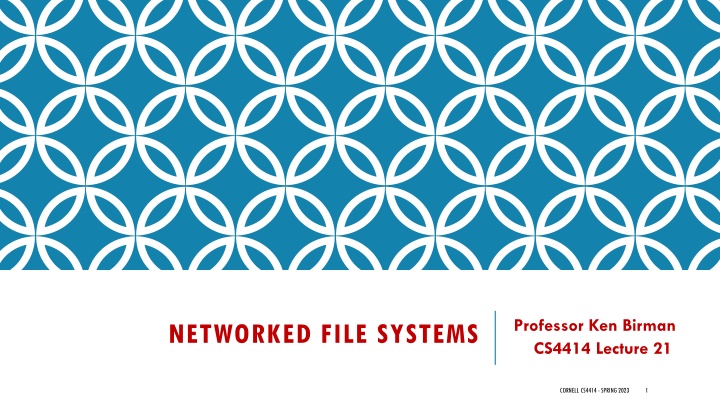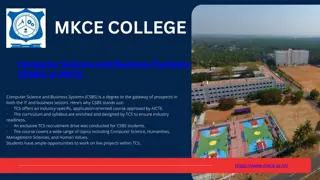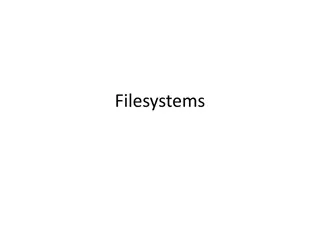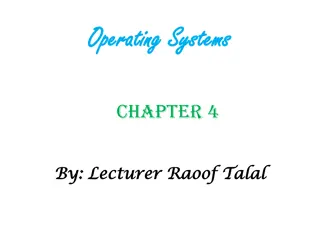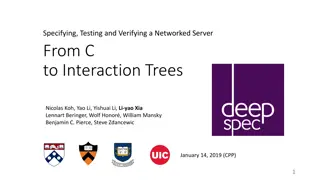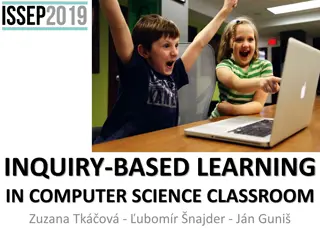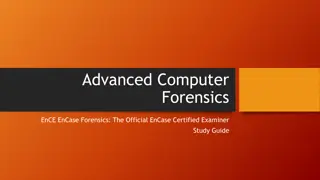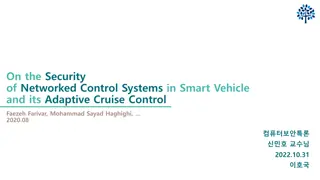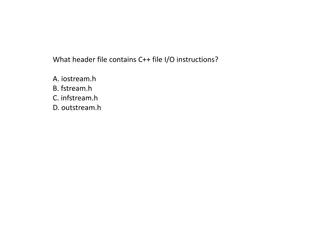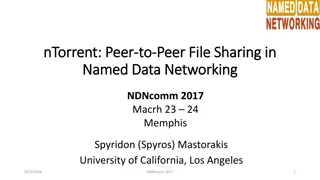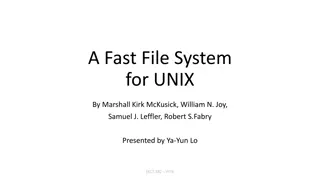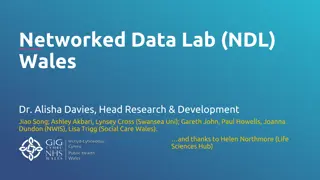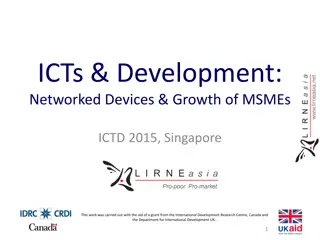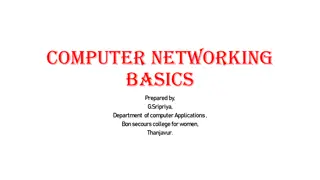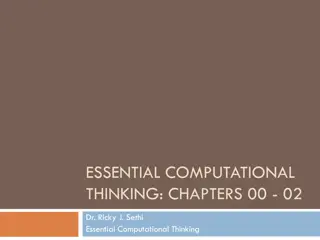Evolution of Networked File Systems in Computer Science
The evolution of networked file systems in the computer science field has been pivotal in enabling remote file storage, distributed coordination, and improved system stability. Starting from Bill Joy's innovations in the BSD version of Unix to the introduction of NFS by Sun Microsystems, the concept of rerouting file system requests to remote machines has revolutionized the way data is stored and accessed. Concepts like Ceph, Zookeeper, and mount points have further advanced the capabilities of networked file systems, providing flexibility and scalability to modern computing environments.
Download Presentation

Please find below an Image/Link to download the presentation.
The content on the website is provided AS IS for your information and personal use only. It may not be sold, licensed, or shared on other websites without obtaining consent from the author.If you encounter any issues during the download, it is possible that the publisher has removed the file from their server.
You are allowed to download the files provided on this website for personal or commercial use, subject to the condition that they are used lawfully. All files are the property of their respective owners.
The content on the website is provided AS IS for your information and personal use only. It may not be sold, licensed, or shared on other websites without obtaining consent from the author.
E N D
Presentation Transcript
Professor Ken Birman CS4414 Lecture 21 NETWORKED FILE SYSTEMS CORNELL CS4414 - SPRING 2023 1
IDEA MAP FOR TODAY With the internet, it is possible for Linux to reroute file system requests to some remote machine. This enables a remote file system Ceph: A remote file system specifically tuned for storing objects Zookeeper: A remote file system for distributed coordination CORNELL CS4414 - SPRING 2023 2
BILL JOY Bill was a UC Berkeley PhD student in 1980. He created the BSD version of Linux (among other things, like vim editor). At the time Unix (pre-Linux) used to crash and end up with damaged file systems, which had to be repaired by hand. Bill rewrote the file system. His innovations improved speed 10x and eliminated the crash issue. He did it using the kinds of ideas we have talked about in CS4414! CORNELL CS4414 - SPRING 2023 3
SUN MICROSYSTEMS Bill started a company, early in the .com boom era. The company took the BSD Linux and created a workstation computer carefully designed for modern users, as of 1980. Their potential clients were purchasing DEC computers at the time, which also had Linux, but included a cluster option CORNELL CS4414 - SPRING 2023 4
The early SUN workstation had limited local storage SUN REMOTE FILE SYSTEM IDEA SUN introduced the network file system or NFS NFS Bill created it. His basic idea was very simple. He mimicked the hardware interface to a normal disk, but talked to it over a network, via a SUN remote procedure call package (like Google GRPC). CORNELL CS4414 - SPRING 2023 5
HOW DID THEY DO IT? First, a little context: The earliest version of Unix only supported a fairly small local file system on a single disk. This quickly was inadequate. Users wanted to share files. The idea of mounting a remote file system emerged. Then this was expanded to deal with disk array hardware, where there are multiple disks in a single big storage unit. CORNELL CS4414 - SPRING 2023 6
CONCEPT: MOUNT POINT Any directory in the active file system, like /mnt/c The mount command maps it to the root of a file system on some storage drive Now, /mnt/c/x lets you access x in the other file system. CORNELL CS4414 - SPRING 2023 7
CONCEPT: DEVICE DRIVER A kernel such as Linux talks to devices through device driver modules, specific to the hardware. So for example, a Western Digital USB hard drive would have an associated device driver that Linux can load and run. CORNELL CS4414 - SPRING 2023 8
ROLE OF THE DEVICE DRIVER? Recall the layered abstractions Dijkstra proposed. A device driver takes a general purpose system, like a WD USB, and creates a uniform way for Linux to talk to it. Linux is one of many operating systems, and Ubuntu is one of many versions of Linux Internally, each of these has its own opinion about the best way to manage a storage device Device driver makes a wide range of devices look standard/uniform. CORNELL CS4414 - SPRING 2023 9
SO (BACK ON TOPIC) SUN created a device driver for a remote storage unit that it would talk to over a network. Now mount can work as usual. Local file system is fast to access, but private and has less capacity. Linux booted from the local file system, then mounts the remote one. Remote file system is massive. We incur a network delay to access it, but it can be shared with others, which is convenient in many ways. CORNELL CS4414 - SPRING 2023 10
ADVANTAGE SUN? DEC s NUMA clustering approach was amazing, but fairly complex. Many customers found it immature and unreliable. SUN s NFS was very simple and robust in part because Linux was extended by SUN to survive even if the NFS crashed or rebooted when the workstation was running. CORNELL CS4414 - SPRING 2023 11
FAMOUS 1980S QUOTE Bill Joy (SUN founder, CTO; created NFS): I came to work one morning and continued to edit a program I was writing. It was open on the screen I hadn t closed it when I left work. At lunch, someone asked me how I liked the new storage product: They had upgraded during the night and I never even noticed! CORNELL CS4414 - SPRING 2023 12
THIS WOULD NOT HAVE WORKED IF SUN RPC USED TCP! SUN remote procedure call used UDP: User Datagram Protocol . Each message is sent by itself. Routing is the same as with TCP, but if any packet is lost, the whole UDP message will be dropped. TCP streams, which are reliable and sequenced. TCP also checks that the two endpoints both remain alive. And TCP has the SSL option, which adds security and endpoint credential checking. CORNELL CS4414 - SPRING 2023 13
SUN COMPETED AGAINST DEC SUN took the approach that each computer is on its own . It might be a client of some remote services, but it would be able to keep running even if those were down. This differed from DEC, an even larger company, where the whole cluster needed to be working for the computer itself to be available . In fact DEC was doing an early NUMA design. CORNELL CS4414 - SPRING 2023 14
FAMOUS 1980S QUOTE Leslie Lamport (Turing Award for distributed computing) Leslie Lamport: Since the start of my career I ve worked on the theory of fault tolerant distributed computing. Yet we have lacked real distributed systems where I could apply this theory. But now the future finally arrived: Today I was unable to work due to the failure of a computer I have never even heard of! CORNELL CS4414 - SPRING 2023 15
ISSUES WITH NETWORKING Bill and Leslie were highlighting two dimensions of modern computing. Bill s experience with NFS was quite good: his workstation never even noticed the new server! Leslie s experience (at SRI and then DEC and then Microsoft, not SUN) highlighted a risk: dependencies on remote components, fault- tolerance issues. He favored strong semantics and fault-tolerance CORNELL CS4414 - SPRING 2023 16
BROADER ISSUE Digital Equipment VAX clusters design was complex and hard to manage. The technology was ahead of what we knew how to do. Leslie was in the early stages of developing a whole mathematical treatment of such questions. Eventually he won a Turing Award for his work. But in 1980, this was all in the future. Perfection is the enemy of good enough Bill favored dumb simplicity, things that work pretty well . CORNELL CS4414 - SPRING 2023 17
SUN RPC RETRANSMITS LOST MESSAGES, THEN EVENTUALLY GIVES UP SUN gave each message a unique id. It would resend a few times if a request or response was dropped. This is all we need normally, when interacting with a server in an active way. When Bill stopped editing, his SUN workstation had no reason to send more messages. So it never noticed that the server was replaced. CORNELL CS4414 - SPRING 2023 18
THE EARLY VERSION OF SUN RPC HAD NO REAL SECURITY Anyone could access any NFS server, read or write any file In fact it even trusted user ids: Anyone could access any server as any legitimate user. After two years, SUN finally fixed this. Security just wasn t the priority for those first two years! CORNELL CS4414 - SPRING 2023 19
CRUX OF SECURITY ISSUE Suppose that machine A says to server S, My user is Professor Schneider. He wishes to edit CS4410-Spr-FinalGrades.xlsx How can S validate that this is a legitimate request from a legitimate user? Someone might have taken machine A over. In fact the entire packet could be forged! CORNELL CS4414 - SPRING 2023 20
OLD APPROACH In the early days, the file server simply trusted its clients. Worried about someone breaking into your network? Then secure your network better! Not our problem your error ! CORNELL CS4414 - SPRING 2023 21
IMPROVEMENT A FEW YEARS LATER SUN deployed a certification infrastructure Trust repository, with ability to issue signed permissions in a unique way: If host A has Professor Schneider logged in, the certificate is unique to host A, for a specified period of time Now host A can present proof that it holds this certificate. Everything is encrypted so anyone snooping will just see random-looking bits, nothing intelligible. CORNELL CS4414 - SPRING 2023 22
MOUNTING AN NFS DISK The NFS driver needed to know a computer s name, to turn this into an IP address. NFS used a standard port number. But then it uses this information only when actually sending requests (to read or write blocks on the remote device) NFS has no reason to chit chat if a machine is idle. CORNELL CS4414 - SPRING 2023 23
AT XEROX Leslie s computer was using a Xerox RPC over TCP. With TCP, if a storage server was removed some evening and replaced with a larger, faster one, even if it has the same IP address and port number, the connection would break TCP is continuously numbering bytes in each direction (SEQ numbers) The new computer wouldn t know about the old, open, TCP session So the session will break next time we use it. CORNELL CS4414 - SPRING 2023 24
THE PUZZLE WITH NETWORKING FAILURES Consider these two cases: 1. Some computer catches fire, crashes, and will never recover. The roles it played (like running an NFS file server) will be moved to some other computer (maybe with the same name) 2. The cat is playing with the network cable, and manages to pull it loose. Someone will notice and plug it back in. No computer crashed at any time. CORNELL CS4414 - SPRING 2023 25
THE PUZZLE WITH NETWORKING FAILURES they look identical! So, in a networked file system, you can see errors that do not ever arise with a local disk. If a local disk fails this is a hardware issue. It may be seriously broken. If a networked disk fails, perhaps this just means there is a transient networking issue and packets cannot get through. CORNELL CS4414 - SPRING 2023 26
LINUX HAS NEVER DEALT WELL WITH THIS! With NFS, we can get some very strange file system outages. For example, many older Linux programs create a file as a way to do distributed locking. The application creates a file lock in some working directory If other applications try and create this same file, their requests fail, and they loop. To release the lock, remove ( unlink ) the file CORNELL CS4414 - SPRING 2023 27
RECALL THAT NFS RETRIES IF AN RPC FAILS Consider this (real) case: Bill opens nsf.c from vim (he wrote this editor, too). The editor wants to lock nsf.c against concurrent edits, so first it creates a file .nsf.c-lock ( invisible unless you know to look for it) The RPC request gets through, but the response is somehow dropped. so, the lock file was created, but Bill s machine doesn t know Bill s machine re-issues the request. But it fails: the lock file exists. Bill s sees Error: File is locked against edits . Why is this wrong? CORNELL CS4414 - SPRING 2023 28
WHAT DOES BILL DO? In fact, he reboots Linux has tools to automatically remove temporary files, and Bill sets them up to also look for and remove any lock files. So, this clears the issue but in an ugly way! CORNELL CS4414 - SPRING 2023 29
OTHER LINUX OPTIONS Modern Linux has a file replace feature: If a file is large, it may take a while to write out, and a crash could leave it corrupted. So how do you rewrite a large file? Create the new version first as a temporary file, and fsync it to disk. Then, replace the old one with the new one. Linux has an atomic rename operation that can do this for you. Rename is atomic on any given machine, including a remote server (NFS just sends the rename request to the server). But if a crash occurs at this moment, the process that called rename can get an error. CORNELL CS4414 - SPRING 2023 30
FAULT TOLERANCE IS A FUN TOPIC! Leslie Lamport was a pioneer in this area. (So, in fact, was Ken) But SUN, with its ultra-simple NFS solution still won . DEC was successful with their Vax Cluster product, but their approach was very complicated and the tools weren t easy to use. SUN systems sometimes acted in weird ways, but rebooting (which removed all lock files!) generally fixed the issues. Neither company exists today But these same puzzles remain! CORNELL CS4414 - SPRING 2023 31
MODERN VERSION OF NFS In fact, NFS persisted and is still available and very widely used But in recent years, people began to use file systems to store objects. They gave each object a name, like a file name. The serialized data would be the file contents. One object one file (with a few exceptions, like log files tracking the history of changes to some object). CORNELL CS4414 - SPRING 2023 32
CEPH FILE SYSTEM Ceph responds to an issue this form of object storage causes: We can easily end up with directories that hold billions of objects NFS file servers were not designed for this and often crashed due to software and design limitations CORNELL CS4414 - SPRING 2023 33
CEPH FILE SYSTEM Size distributions for objects are very different than for older NFS files: File systems are optimized for the most common cases. In NFS these tended to be small text files and large photos or videos With objects, the distribution simply looks different. CORNELL CS4414 - SPRING 2023 34
CEPH FILE SYSTEM Lifetimes for objects are very different than for older Linux files: Even in Linux, a surprising number of files are created, but then immediately deleted. Some, like lock files, are never even read. Linux has some optimizations to avoid pointless I/O for such cases. With objects, the lifetime distribution simply looks different. CORNELL CS4414 - SPRING 2023 35
CEPH HAS NO IDEA WHAT IS IN AN OBJECT It only sees the serialized form of an object. Recall that when we serialize, an object is converted into a byte array of some size. Later the application would deserialize and reconstruct the object contents. Ceph never sees object definition and cannot call the methods CORNELL CS4414 - SPRING 2023 36
YOU CAN ENCRYPT YOUR OBJECTS With every form of Linux, you can specify that you want a file volume to be encrypted. Don t lose the key! In such cases, all the bits that are written will first be encrypted, and later when you do a read, the data will be decrypted. In Linux file systems this is block by block and invisible to you, once you enable it. CORNELL CS4414 - SPRING 2023 37
CEPH SUPPORTS ENCRYPTION TOO You can actually encrypt your own serialized objects. But the Ceph feature will cover entire storage systems, even if they have many servers. Thus if someone were to steal a storage drive, they just see random bits (unless they are friends of the keymaker) Keymaker in the Matrix films CORNELL CS4414 - SPRING 2023 38
CEPH ARCHITECTURE We discussed complex systems built from multiple processes. Ceph has this sort of structure! Each type of element is a separate process. New more storage? Just run more storage nodes! CORNELL CS4414 - SPRING 2023 39
EXAMPLES OF CEPH FEATURES Efficient ways of managing directories with immense numbers of objects in them, such as fast lookup to find the file control information (the inode). Special ways of packing data so that with large numbers of small objects, a whole block isn t wasted for each. With really big files, striping over multiple storage units. CORNELL CS4414 - SPRING 2023 40
FILE STRIPING CONCEPT Slice file into chunks and then write chunk by chunk across several storage units. Here, each stipe has 4 chunks. Graphic is by Jeff Chase @ Duke. CORNELL CS4414 - SPRING 2023 41
CEPH RADOS CONCEPT: RELIABLE ARRAY OF DISTRIBUTED OBJECT STORAGE DEVICES Ceph has one set of servers that handle object metadata This include file names, sizes, date of creation, lifetime, etc The RADOS layer is a set of servers that hold striped data. It is also used to hold the metdata blocks. Storage can be provided by any networked servers that support the RADOS API. CORNELL CS4414 - SPRING 2023 42
MORE CEPH FEATURES Crashes are a worry, so Ceph automatically makes a backup copy (replica) for each object when it is first stored. Replication is done inside RADOS. Each storage server has a primary and a backup. When data is stored to the primary, it is simultaneously copied to the backup. The backup can be accessed (read only) when if the primary is down. CORNELL CS4414 - SPRING 2023 43
MORE CEPH FEATURES Ceph tries to avoid wasted I/O. Object lifetimes can be short. Many are created, but then deleted within a few milliseconds! Ceph is very quick to make the replica but holds it in memory No disk I/O occurs unless the object hangs around for a while. CORNELL CS4414 - SPRING 2023 44
CEPH IS OPEN SOURCE! which doesn t always mean free But in fact there is a free version of Ceph that you can download and use. There is also a productized version with many features aimed at big professional users. Like CERN s giant particle accelerator! CORNELL CS4414 - SPRING 2023 45
A SECOND POPULAR NETWORKED FILE SYSTEM We saw that failures cause problems for Linux locks. Ceph replication doesn t address the core problem of a client not being able to tell whether a machine crashed or is healthy. In fact Ceph itself won t allow writes unless RADOS has an operational primary and a backup. Zookeeper is a file system specifically targeting high availability. CORNELL CS4414 - SPRING 2023 46
Created by Flaviu Junqueria in the Apache project Flaviu Junqueria Role is to hold data like which machines are healthy? or other kinds of configuration files. Free, open source. CORNELL CS4414 - SPRING 2023 47
HOW ZOOKEEPER IS USED We often see systems that use Zookeeper plus Ceph plus normal Linux file storage on the local machine or even a datacenter FS. Each kind of networked file system is really a specialist! Zookeeper rarely has many files, never allows large files, and the files themselves tend to be kept for as long as the system runs CORNELL CS4414 - SPRING 2023 48
FAULT-TOLERANCE Zookeeper will self heal if it is damaged by a crash. It also automatically reports if any of your processes fails. Includes a somewhat broken checkpointing option, for use if the whole system suddenly shuts down. Core issue: it can suffer amnesia about recent events if it crashes. We ll discuss this more in Lecture 21. CORNELL CS4414 - SPRING 2023 49
CLEVER SPECIAL FEATURE IN ZOOKEEPER Normal Linux file systems (including Ceph) don t track file versions. You just create the file, write data, and perhaps later rewrite the file (or replace it). With Zookeeper, files also have version numbers. A process can request a file replace if the version number is currently 21 . CORNELL CS4414 - SPRING 2023 50
